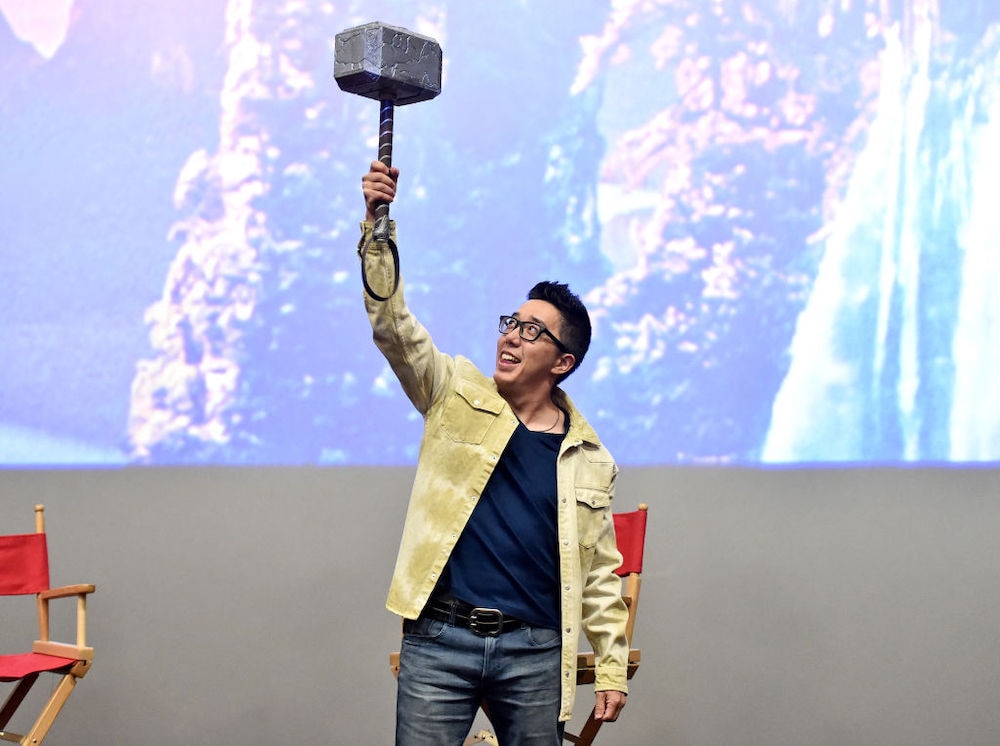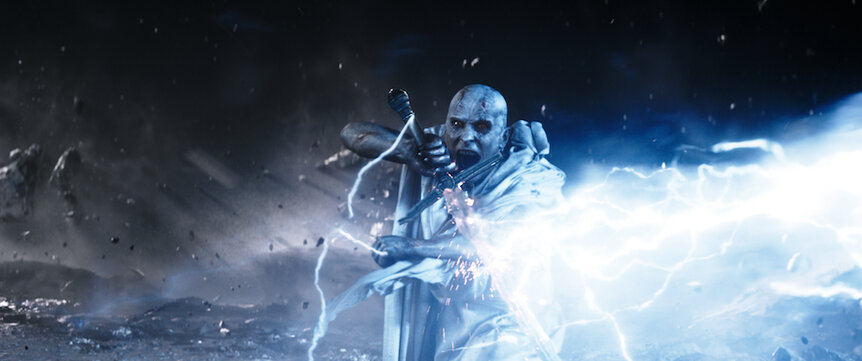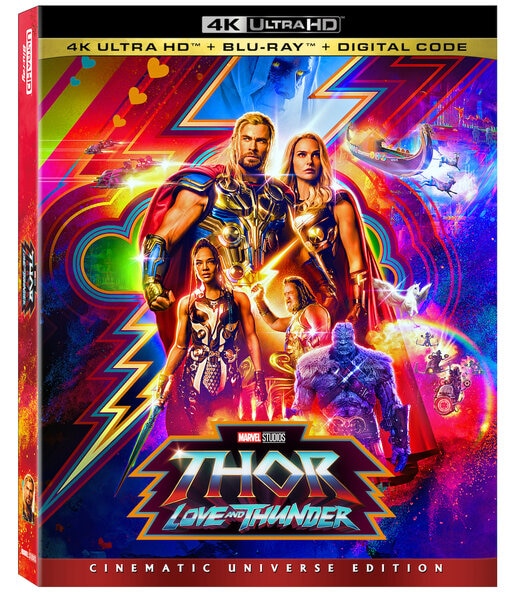Create a free profile to get unlimited access to exclusive videos, sweepstakes, and more!
Marvel's director of visual development talks 'Love and Thunder' and the future of the MCU
"The picture gets bigger and bigger, even after Endgame," the director of visual development tells SYFY WIRE.

To those who say the MCU should have quit after Avengers: Endgame, Andy Park has a message for you: “The picture gets bigger and bigger.”
For the last 12 years, Park has served as the director of Marvel Studios’ Visual Development team, working closely with Marvel mastermind Kevin Feige and a revolving door of celebrated filmmakers to create heaps of concept art and refine the character designs for every project that has graced our screens since Tony Stark first built his Iron Man suit in a cave (with a box of scraps!!!).
With Thor: Love and Thunder arriving on physical home video next week, SYFY WIRE got a chance to speak with Park — not only about Taika Waititi’s latest adventure with the God of Thunder, but also about the future of the shared comic book mythos, whose next big bag, Kang the Conquerer, looms large over the blossoming multiverse.
Before we jump into Love and Thunder, I’d like to take a quick macro look at Phase 4. Now that the MCU is expanding more than ever before, how would you say your job has evolved and where can we expect the universe to go from here?
It's kind of the same. I've been here for 12-and-a-half years since 2010, starting with the first Captain America film (a little bit on that first Thor film) and then really just diving into the Avengers. It's been a journey of constantly introducing new characters, new worlds, new themes, new genres. But it's really about characters.
That's what the Marvel Studios Visual Development department is all about. We exist to help flesh out these characters that initially come from the amazing creators in the Marvel comic books world — from Jack Kirby, Stan Lee, Steve Ditko, and all the decades afterward. It just gets wider and wider, the picture gets bigger and bigger, even after Endgame. You think, "What else in the world is there to go? We’ve seen everything! We’ve seen the cosmic, we've seen this and that." But moving forward, we're gonna have Ant-Man and the Wasp: Quantumania, we’re gonna be seeing that pocket of the universe; we're going to be seeing Thunderbolts … It’s the exact same model as the Marvel Comics … It's been many, many decades of just building upon characters and worlds, but it's all in the same universe.
Looking at the latest Thor film, how did you want to carry on the vibrancy that Taika Waititi brought to Ragnarok?
Working with Taika was just lots of fun. We're creating all these characters, but we’re also working with each individual filmmaker and they all have their own voice. We have four Thor movies, but the third and fourth are quite different from the first two. And yet, it's the same character. That's the exact same models as Marvel Comics, right? The way Stan Lee wrote Thor is quite different from someone like Michael Straczynski. It was really fun to get back into the Thor world with Taika because I know when I work with him, I'm in for a ride. He’s so much fun. He's constantly joking around and he's really just entertaining [Laughs]. But his ideas are very extreme and out there. He's not scared to try something. There might be times when we're scared [and say] "Ahhh, I don't know…that might be a little too far design-wise." So he'll like push us to be like, "Hey, let's go there." Whether that becomes the design or we pivot back a little bit, we wouldn't have found this pivot without going to the extreme. That’s Taika pretty much in a nutshell.
We get to see Eternity in this film is pretty simple, yet grandiose. Was there ever any talk of having the character be more anthropomorphic, like in the comics?
Yes. Anytime we do a character, there’s going to be lots of iterations. That's another reason why you need to eventually get The Art of Thor: Love and Thunder … [For] Eternity, there were a lot of artists — not only our department — that did versions. We did a whole range of designs, from something very grand and ethereal, as well as cosmic and things that are visually like, "Whoa, what's going on?" to what you see, which is very comic accurate, but quite simple. But that's why we exist because we're going to give them all those options ... I think [VFX Supervisor] Jake Morrison did an interview [where he explained that] Taika wanted to go simple at the end of the day because they wanted to focus on Gorr, Thor, and Mighty Thor, and then eventually Love [Gorr’s daughter].
There are plenty of divine beings in this movie, especially once the plot shifts to Omnipotence City. I’m sure you had a million ideas to fill that space…
That was really fun to see it form. [Costume designer] Mayes Rubeo and her artists were in charge of designing those characters. Early on, we did a keyframe by one of our artists named John Staub, which depicts that whole scene in a nutshell [in order] to get the overall look and feel. He did a lot of research into Marvel Comics, looking at the different gods in there. So if you see that keyframe, you'll see the pretty comic accurate [characters] he spliced all throughout the background, just as an idea. Those didn't necessarily make it into the film. From that point on, Mayers Rubeo and her team really fleshed out all the other characters that you see in there. We were more focused on the main characters like Thor, Mighty Thor, Gorr, the creatures, Valkyrie, Sif, and all that kind of stuff.
Speaking of Gorr, I thought his shadow monsters were really cool. Can you talk about the impetus behind their design?
That was fun because we did a lot of different interpretations ... from things that were a little bit more graphic to, "Do they become realized as flesh-type of creatures?" We didn't know, so we gave them a lot of different options, as well as [asking], "How scary Do we go?" That's always a thing we’re balancing because we'll give them options that are like, "Whoa, that's really creepy!" to others that are like, "Oh, that's kind of funny!" We’ll give them the full range.
While [Taika] was writing the script, his daughter read that part and she's like, "What does a shadow monster look like?" And he's like, "I don’t know, why don’t you draw it?" Then she drew something and that became the idea. We started getting drawings from Taika’s kids, as well as Christian Bale’s, and I think there were producers that were having their kids do some drawings. We took those drawings and we interpreted that [and asked:] "How do we make that realistic and scary?" ... Gorr’s daughter is doing chalk drawings on a rock when they're in the desert and also in their cave area. That’s why they're based off of children's drawings, because those creatures come from her imagination. He saw those drawings that his daughter did and he fully realized them in those creatures.
Fans got some really exciting MCU reveals at D23 Expo, including two pieces of teaser art you drew for Thunderbolts and Quantumania. How do you work to capture the spirit of those films without giving too much away?
Because we're a unique department in the film industry, where we're full-time, we work even in post with VFX. We [also] work with marketing a lot of times. So we'll get to do those illustrations and posters for Comic-Cons. I did that one for Quantumania and that's kind of like the first full reveal of anything for the film. It’s hinting at the Quantum-Verse, as well as hinting at Kang without showing too much. And, of course, three things that you see clearly are the costumes of Cassy, Scott, and Hope … and you see a little bit of their personalities in there. Kevin had the idea that as they come out, each one's going to be revealed. So I kind of had to go back into the illustration to make it work for that reveal as the actors are coming out. It's an honor to be able to be part of those kinds of introductions.
What is your favorite part of getting to work on these projects?
The 14-year-old in me, reading Marvel comic books in the ‘80s, and ‘90s… to be able to interpret these characters and actualize them and make them come into reality for the Marvel Cinematic Universe, that's something that is still kind of crazy to me. But I think it's so rewarding to be able to lead the Visual Development team here at Marvel Studios. I've been here for 12-and-a-half years, it's been an honor lifetime. I drew comic books back in the day, I worked in video games, doing designs on God of War, but working here has been special because of the people I get to work with. The people here are so talented.
I think all of us collectively agree what a special place this is and to be able to contribute to these projects by leaders that we truly trust, obviously starting with Kevin Feige. We trust in his vision and where he's going. We’re constantly impressed. Even some decisions we question like, ‘Guardians the Galaxy right after Avengers? I don't know about that decision...’ But then we work on it and look what happens. Then Ant-Man comes out and we're like, ‘I don't know about Ant-Man. Maybe it's too soon for a movie that's called Ant-Man.’ He knows what he's doing. It's really been an honor to be able to work with the people here. It's been an amazing time.
This interview has been edited for length and clarity
Thor: Love and Thunder is now available to stream on Disney+. The film can also be purchased via Digital and VOD platforms for $19.99 ahead of its physical home release (Blu-Ray, DVD, and 4K Ultra HD) on Tuesday, Sep. 27.
Looking for some more sci-fi? Check out shows like Resident Alien, Brave New World, Project Blue Book, Eureka, Heroes, Intergalactic, and more streaming now on Peacock.




























